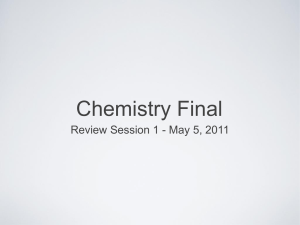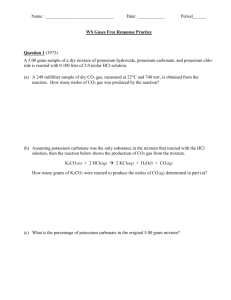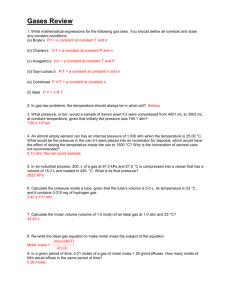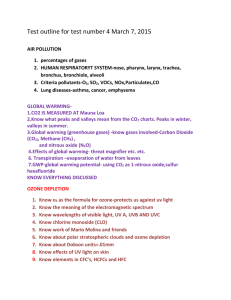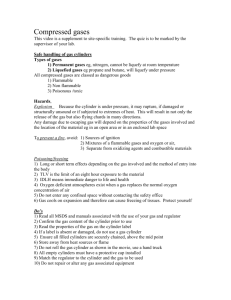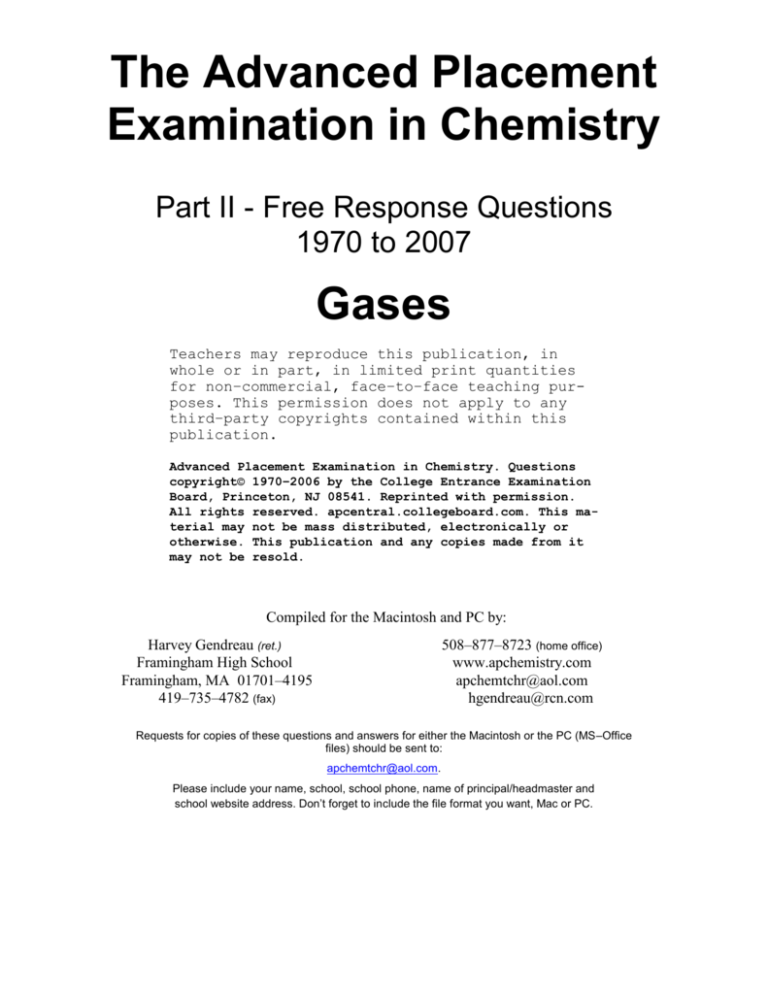
The Advanced Placement
Examination in Chemistry
Part II - Free Response Questions
1970 to 2007
Gases
Teachers may reproduce this publication, in
whole or in part, in limited print quantities
for non–commercial, face–to–face teaching purposes. This permission does not apply to any
third–party copyrights contained within this
publication.
Advanced Placement Examination in Chemistry. Questions
copyright© 1970–2006 by the College Entrance Examination
Board, Princeton, NJ 08541. Reprinted with permission.
All rights reserved. apcentral.collegeboard.com. This material may not be mass distributed, electronically or
otherwise. This publication and any copies made from it
may not be resold.
Compiled for the Macintosh and PC by:
Harvey Gendreau (ret.)
Framingham High School
Framingham, MA 01701–4195
419–735–4782 (fax)
508–877–8723 (home office)
www.apchemistry.com
apchemtchr@aol.com
hgendreau@rcn.com
Requests for copies of these questions and answers for either the Macintosh or the PC (MS–Office
files) should be sent to:
apchemtchr@aol.com.
Please include your name, school, school phone, name of principal/headmaster and
school website address. Don’t forget to include the file format you want, Mac or PC.
Gases
page 2
1971
2 HCOONa + H2SO4 2 CO + 2 H2O + Na2SO4
A 0.964 gram sample of a mixture of sodium formate and sodium chloride is analyzed by adding sulfuric acid.
The equation for the reaction for sodium formate with sulfuric acid is shown above. The carbon monoxide
formed measures 242 milliliters when collected over water at 752 torr and 22.0C. Calculate the percentage of
sodium formate in the original mixture.
1971 B
At 20C the vapor pressure of benzene is 75 torr, and the vapor pressure of toluene is 22 torr. Solutions in both
parts of this question are to be considered ideal.
(a) A solution is prepared from 1.0 mole of biphenyl, a nonvolatile solute, and 49.0 moles of benzene. Calculate the vapor pressure of the solution at 20C.
(b) A second solution is prepared from 3.0 moles of toluene and 1.0 mole of benzene. Determine the vapor
pressure of this solution and the mole fraction of benzene in the vapor.
1972
A 5.00 gram sample of a dry mixture of potassium hydroxide, potassium carbonate, and potassium chloride is
reacted with 0.100 liter of 2.0 molar HCl solution.
(a) A 249 milliliter sample of dry CO2 gas, measured at 22C and 740 torr, is obtained from the reaction. What
is the percentage of potassium carbonate in the mixture?
(b) The excess HCl is found by titration to be chemically equivalent to 86.6 milliliters of 1.50 molar NaOH.
Calculate the percentages of potassium hydroxide and of potassium chloride in the original mixture.
1973 B
A 6.19 gram sample of PCl5 is placed in an evacuated 2.00 liter flask and is completely vaporized at 252C.
(a) Calculate the pressure ion the flask if no chemical reaction were to occur.
(b) Actually at 252C the PCl5 is partially dissociated according to the following equation:
PCl5(g) PCl3(g) + Cl2(g)
The observed pressure is found to be 1.00 atmosphere. In view of this observation, calculate the partial
pressure of PCl5 and PCl3 in the flask at 252C.
1976 D
When the molecular weight of a volatile liquid is calculated from the weight, volume, temperature, and pressure
of a sample of that liquid when vaporized, the assumption is usually made that the gas behaves ideally. In fact at
a temperature not far above the boiling point of the liquid, the gas is not ideal. Explain how this would affect the
results of the molecular weight determination.
1982 D
(a) From the standpoint of the kinetic-molecular theory, discuss briefly the properties of gas molecules that
cause deviations from ideal behavior.
(b) At 25C and 1 atmosphere pressure, which of the following gases shows the greatest deviation from ideal
behavior? Give two reasons for your choice.
CH4
SO2
O2
H2
(c) Real gases approach ideality at low pressure, high temperature, or both. Explain these observations.
Copyright ⌐ 1970 to 1998 by Educational Testing Service, Princeton, NJ 08541. All rights reserved. For face-to-face teaching purposes, classroom teachers
are permitted to reproduce the questions. Portions copyright ⌐ 1993-8 by Unlimited Potential, Framingham, MA 01701-2619.
Gases
page 3
1984 C
The van der Waals equation of state for one mole of a real gas is as follows:
(P + a/V2)(V - b) = RT
For any given gas, the values of the constants a and b can be determined experimentally. Indicate which physical
properties of a molecule determine the magnitudes of the constants a and b. Which of the two molecules, H2 or
H2S, has the higher value for a and which has the higher value for b? Explain.
One of the van der Waals constants can be correlated with the boiling point of a substance. Specify which
constant and how it is related to the boiling point.
1986 B
Three volatile compounds X, Y, and Z each contain element Q. The percent by weight of element Q in each
compound was determined. Some of the data obtained are given below.
Compound Percent by Weight Molecular
of Element Q
Weight
X
64.8%
?
Y
73.0%
104.
Z
59.3%
64.0
(a) The vapor density of compound X at 27 degrees Celsius and 750. mm Hg was determined to be 3.53 grams
per liter. Calculate the molecular weight of compound X.
(b) Determine the mass of element Q contained in 1.00 mole of each of the three compounds.
(c) Calculate the most probable value of the atomic weight of element Q.
(d) Compound Z contains carbon, hydrogen, and element Q. When 1.00 gram of compound Z is oxidized and
all of the carbon and hydrogen are converted to oxides, 1.37 grams of CO2 and 0.281 gram of water are
produced. Determine the most probable molecular formula.
1986 D
Give a scientific explanation for each of the following observations. Use equations or diagrams if they seem relevant.
(c) A hot-air balloon must be larger than a helium-filled balloon in order to lift the same weight.
Answer:
(c) Hot air is denser than helium. OR Hot air has much less lifting power per unit volume than helium has.
A scientific explanation of the volume/lift relation.
1990 B
A mixture of H2(g), O2(g), and 2 millilitres of H2O(l) is present in a 0.500 litre rigid container at 25C. The number of moles of H2 and the number of moles of O2 are equal. The total pressure is 1,146 millimetres mercury.
(The equilibrium vapor pressure of pure water at 25C is 24 millimetres mercury.)
The mixture is sparked, and H2 and O2 react until one reactant is completely consumed.
(a) Identify the reactant remaining and calculate the number of moles of the reactant remaining.
(b) Calculate the total pressure in the container at the conclusion of the reaction if the final temperature is
90C. (The equilibrium vapor pressure of water at 90C is 526 millimetres mercury.)
(c) Calculate the number of moles of water present as vapor in the container at 90C.
Copyright ⌐ 1970 to 1998 by Educational Testing Service, Princeton, NJ 08541. All rights reserved. For face-to-face teaching purposes, classroom teachers
are permitted to reproduce the questions. Portions copyright ⌐ 1993-8 by Unlimited Potential, Framingham, MA 01701-2619.
Gases
page 4
1993 D
Observations about real gases can be explained at the molecular level according to the kinetic molecular theory
of gases and ideas about intermolecular forces. Explain how each of the following observations can be interpreted according to these concepts, including how the observation supports the correctness of these theories.
(a) When a gas-filled balloon is cooled, it shrinks in volume; this occurs no matter what gas is originally placed
in the balloon.
(b) When the balloon described in (a) is cooled further, the volume does not become zero; rather, the gas becomes a liquid or solid.
(c) When NH3 gas is introduced at one end of a long tube while HCl gas is introduced simultaneously at the
other end, a ring of white ammonium chloride is observed to form in the tube after a few minutes. This ring
is closer to the HCl end of the tube than the NH3 end.
(d) A flag waves in the wind.
1994 B
A student collected a sample of hydrogen gas by the displacement of water as shown by the diagram above. The
relevant data are given in the following table.
GAS SAMPLE DATA
Volume of sample
90.0 mL
Temperature
25C
Atmospheric Pressure
745 mm Hg
Equilibrium Vapor Pressure
of H2O (25C)
23.8 mm Hg
(a) Calculate the number of moles of hydrogen gas collected.
(b) Calculate the number of molecules of water vapor in the sample of gas.
(c) Calculate the ratio of the average speed of the hydrogen molecules to the average speed of the water vapor
molecules in the sample.
(d) Which of the two gases, H2 or H2O, deviates more from ideal behavior? Explain your answer.
1995 B (repeated in thermochem section)
Propane, C3H8, is a hydrocarbon that is commonly used as fuel for cooking.
(a) Write a balanced equation for the complete combustion of propane gas, which yields CO2(g) and H2O(l).
(b) Calculate the volume of air at 30C and 1.00 atmosphere that is needed to burn completely 10.0 grams of
propane. Assume that air is 21.0 percent O2 by volume.
(c) The heat of combustion of propane is -2,220.1 kJ/mol. Calculate the heat of formation, Hf, of propane
given that Hf of H2O(l) = -285.3 kJ/mol and Hf of CO2(g) = -393.5 kJ/mol.
(d) Assuming that all of the heat evolved in burning 30.0 grams of propane is transferred to 8.00 kilograms of
water (specific heat = 4.18 J/g.K), calculate the increase in temperature of water.
Copyright ⌐ 1970 to 1998 by Educational Testing Service, Princeton, NJ 08541. All rights reserved. For face-to-face teaching purposes, classroom teachers
are permitted to reproduce the questions. Portions copyright ⌐ 1993-8 by Unlimited Potential, Framingham, MA 01701-2619.
Gases
page 5
1996 D (Required)
Represented above are five identical balloons, each filled to the same volume at 25C and 1.0 atmosphere pressure with the pure gases indicated.
(a) Which balloon contains the greatest mass of gas? Explain.
(b) Compare the average kinetic energies of the gas molecules in the balloons. Explain.
(c) Which balloon contains the gas that would be expected to deviate most from the behavior of an ideal gas?
Explain.
(d) Twelve hours after being filled, all the balloons have decreased in size. Predict which balloon will be the
smallest. Explain your reasoning.
2003 B
A rigid 5.00 L cylinder contains 24.5 g of N2(g) and 28.0 g of O2(g)
(a) Calculate the total pressure, in atm, of the gas mixture in the cylinder at 298 K.
(b) The temperature of the gas mixture in the cylinder is decreased to 280 K. Calculate each of the following.
(i) The mole fraction of N2(g) in the cylinder.
(ii) The partial pressure, in atm, of N2(g) in the cylinder.
(c) If the cylinder develops a pinhole-sized leak and some of the gaseous mixture escapes, would the ratio
N2 (g )
in the cylinder increase, decrease, or remain the same? Justify your answer.
O2 ( g )
A different rigid 5.00 L cylinder contains 0.176 mol of NO(g) at 298 K. A 0.176 mol sample of O2(g) is added to
the cylinder, where a reaction occurs to produce NO2(g).
(d) Write the balanced equation for the reaction.
(e) Calculate the total pressure, in atm, in the cylinder at 298 K after the reaction is complete.
2004 D
Answer the following questions about carbon monoxide, CO(g), and carbon dioxide, CO2(g). Assume that both
gases exhibit ideal behavior.
(a) Draw the complete Lewis structure (electron dot diagram) for the CO molecule and for the CO2 molecule.
(b) Identify the shape of the CO2 molecule.
(c) One of the two gases dissolves readily in water to form a solution with a pH below 7. Identify the gas and
account for this observation by writing a chemical equation.
(d) A 1.0 mol sample of CO(g) is heated at constant pressure. On the graph below, sketch the expected plot of
volume verses temperature as the gas is heated.
Copyright ⌐ 1970 to 1998 by Educational Testing Service, Princeton, NJ 08541. All rights reserved. For face-to-face teaching purposes, classroom teachers
are permitted to reproduce the questions. Portions copyright ⌐ 1993-8 by Unlimited Potential, Framingham, MA 01701-2619.
Gases
page 6
(e) Samples of CO(g) and CO2(g) are placed in 1 L containers at the conditions in the diagram below.
(i) Indicate whether the average kinetic energy of the CO2 is greater than, equal to, or less than the average kinetic energy of the CO(g) molecules. Justify your answer.
(ii) Indicate whether the root-mean-square speed of the CO2(g) molecules is greater than, equal to or less
than the root-mean-square speed of the CO(g) molecules. Justify your answer.
(iii) Indicate whether the number of CO2(g) molecules is greater than, equal, or less than the number of
CO(g) molecules. Justify your answer.
Beginning with the 2007 examination, the numerical problems, 1, 2, and 3, are Part A (part A). Students may use a calculator for this
part (55 minutes). Part B (40 minutes) is the three reactions question (predict the products of a reaction, balance, and answer a short
question regarding the reaction) and the two theory questions. A laboratory question could be in either part A or B. NO calculator is
allowed in part B.
2009 part A, question #3, form B
2 H2O2(aq) → 2 H2O(l) + O2(g)
The mass of an aqueous solution of H2O2 is 6.951 g. The H2O2 in the solution decomposes completely according to the reaction represented above. The O2(g) produced is collected in an inverted graduated tube over water
at 23.4°C and has a volume of 182.4 mL when the water levels inside and outside of the tube are the same. The
atmospheric pressure in the lab is 762.6 torr, and the equilibrium vapor pressure of water at 23.4°C is 21.6 torr.
(a) Calculate the partial pressure, in torr, of O2(g) in the gas-collection tube.
(b) Calculate the number of moles of O2(g) produced in the reaction.
(c) Calculate the mass, in grams, of H2O2 that decomposed.
(d) Calculate the percent of H2O2 , by mass, in the original 6.951 g aqueous sample.
2011 form B, question #2
An 8.55 mol sample of methanol, CH3OH, is placed in a 15.0 L evacuated rigid tank and heated to 327°C. At
that temperature, all of the methanol is vaporized and some of the methanol decomposes to form carbon monoxide gas and hydrogen gas, as represented in the equation below.
Copyright ⌐ 1970 to 1998 by Educational Testing Service, Princeton, NJ 08541. All rights reserved. For face-to-face teaching purposes, classroom teachers
are permitted to reproduce the questions. Portions copyright ⌐ 1993-8 by Unlimited Potential, Framingham, MA 01701-2619.
Gases
page 7
CH3OH(g) CO(g) + 2 H2(g)
(a) The reaction mixture contains 6.30 mol of CO(g) at equilibrium at 327°C.
(i) Calculate the number of moles of H2(g) in the tank.
(ii) Calculate the number of grams of CH3OH(g) remaining in the tank.
(iii) Calculate the mole fraction of H2(g) in the tank.
(iv) Calculate the total pressure, in atm, in the tank at 327°C.
(b) Consider the three gases in the tank at 327°C: CH3OH(g), CO(g) , and H2(g).
(i) How do the average kinetic energies of the molecules of the gases compare? Explain.
(ii) Which gas has the highest average molecular speed? Explain.
(c) The tank is cooled to 25°C, which is well below the boiling point of methanol. It is found that small
amounts of H2(g) and CO(g) have dissolved in the liquid CH3OH. Which of the two gases would you expect
to be more soluble in methanol at 25°C? Justify your answer.
2012 A (student average = 4.05 of 10 pts.)
A sample of pure, gaseous hydrocarbon is introduced into a previously evacuated rigid 1.00 L vessel. The pressure of the gas is 0.200 atm at a temperature of 127°C.
(a) Calculate the number of moles of the hydrocarbon in the vessel.
(b) O2(g) is introduced into the same vessel containing the hydrocarbon. After the addition of the O2(g), the total
pressure of the gas mixture in the vessel is 1.40 atm at 127°C. Calculate the partial pressure of O2(g) in the
vessel.
The mixture of the hydrocarbon and oxygen is sparked so that a complete combustion reaction occurs, producing CO2(g) and H2O(g). The partial pressures of these gases at 127°C are 0.600 atm for CO2(g) and 0.800 atm for
H2O(g). There is O2(g) remaining in the container after the reaction is complete.
(c) Use the partial pressures of CO2(g) and H2O(g) to calculate the partial pressure of the O2(g) consumed in the
combustion.
(d) On the basis of your answers above, write the balanced chemical equation for the combustion reaction and
determine the formula of the hydrocarbon.
(e) Calculate the mass of the hydrocarbon that was combusted.
Copyright ⌐ 1970 to 1998 by Educational Testing Service, Princeton, NJ 08541. All rights reserved. For face-to-face teaching purposes, classroom teachers
are permitted to reproduce the questions. Portions copyright ⌐ 1993-8 by Unlimited Potential, Framingham, MA 01701-2619.

